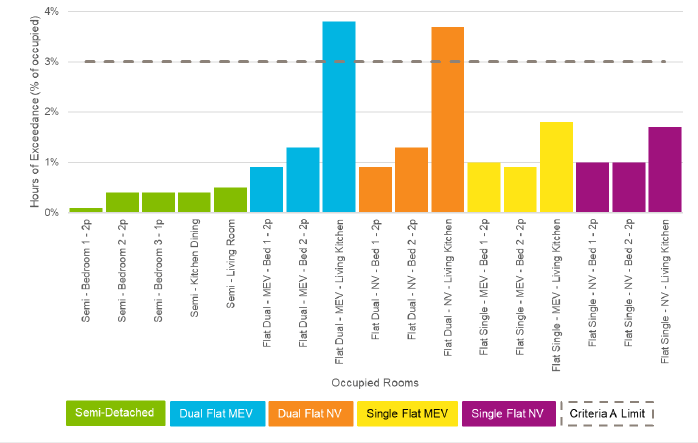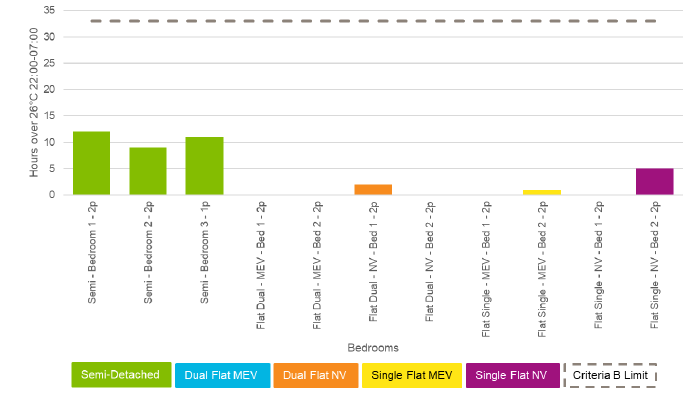Building regulations - overheating risk in new homes: research report
Research into overheating risk in new homes. Produced in support of proposed improvements to energy standards for new buildings within Scottish building regulations in 2021.
This document is part of a collection
3. Results
CIBSE TM59 Criteria and Building Category
3.1 CIBSE TM59 sets out two compliance criteria for dwellings; both need to be met to demonstrate an acceptable risk of overheating:
Criterion A applies to living rooms, kitchens and bedrooms. It requires that the internal temperature does not exceed a defined comfort temperature by 1°C or more for more than 3% of the occupied hours over the summer period (1st May to 30th September).
Criterion B applies to bedrooms only and requires that the internal temperature between 10pm and 7am shall not exceed 26°C for more than 1% of annual hours. Therefore 33 hours or more is recorded as a fail.
3.2 The assessment has been run assuming Category II buildings, which is the same as the previous England assessment. Category II assumes that the buildings have a normal level of expectation of being occupied by vulnerable and fragile persons.
Results
3.3 Figure 1 and Figure 2 show how well each of the dwelling typologies met Criterion A and Criterion B respectively based on the outputs from the dynamic thermal simulation modelling.
3.4 The semi-detached house and the two single-aspect flats all passed both Criteria A and B of CIBSE TM59. Both dual-aspect flat typologies passed Criteria B of CIBSE TM59 (bedrooms), but both living rooms failed Criteria A albeit to a limited extent.
3.5 For the sample dwellings used in this analysis, the greater glazed area of the dual-aspect flat increased the solar gains to the extent that the net effect was to increase the risk of overheating compared to single-aspect flats. It is noted from experience that, depending on the design and location, dual-aspect flats can be at lower risk of overheating than single-aspect flats because the dual-aspect provides the potential to benefit from cross-ventilation (where wind drives greater ventilation rates through the dwelling).


Mitigation Measures
3.6 Based on these results, the Scottish Government will need to consider whether to require mitigation measures to all new dwellings or only specific dwelling typologies. For both England and Wales, the consultation-stage Approved Documents propose mitigation measures based on characteristics of the dwelling (e.g. single or multiple aspect facades).
3.7 As the results of this analysis showed that dual-aspect building typologies only exceeded Criterion B to a limited extent, it may be possible to sufficiently reduce the overheating risk through improved occupant behaviour alone. For example, guidance could be provided by the Scottish Government on ways in which occupant behaviour could reduce internal temperatures during the summer period.
3.8 Both England and Wales have evaluated similar packages of passive measures to control the overheating risk. Each package included measures to reduce solar gains entering the building and some had additional ventilation provisions to remove heat from the building. A further package was evaluated which, in addition to these measures, also included thermal mass to moderate the peak temperature in the building[1]. The passive packages evaluated by England and Wales are summarised in Table 3.
3.9 Both the English and Welsh analysis showed higher exceedances of the CIBSE TM59 criteria than this analysis for Scotland. It is noted that for Wales they assessed the overheating risk based on 'Category I buildings', i.e. it assumes that the dwellings have a high probability of being occupied by vulnerable and fragile persons and results in Criterion A being more stringent. England assessed the overheating risk based on 'Category II buildings' as is the case for the Scottish analysis presented in this paper.
3.10 Given that the dual-aspect flats only exceeded Criterion A to a limited extent, the results suggest that all of the passive packages presented in Table 3 could be used to comply with Criterion A and that there is no need for active cooling to comply. It is understood that English and Welsh Building Regulations cannot control the fitting of internal blinds and, if that is similarly the case in Scotland, then Package 1 would not be suitable for including in Scottish Building Standards. Package 5 would be expected to be the lowest capital cost option but this most restricts the glazing area in flats which will reduce natural daylighting and may make reduce demand (and the price that the developer can charge) for such housing. Package 2 is expected to have higher capital costs than Package 5 but does allow for greater glazing areas in flats.
| Package | Details |
|---|---|
| Package 1 |
|
| Package 2 |
|
| Package 3 |
|
| Package 4 |
|
| Package 5 |
|
Contact
Email: buildingstandards@gov.scot
There is a problem
Thanks for your feedback